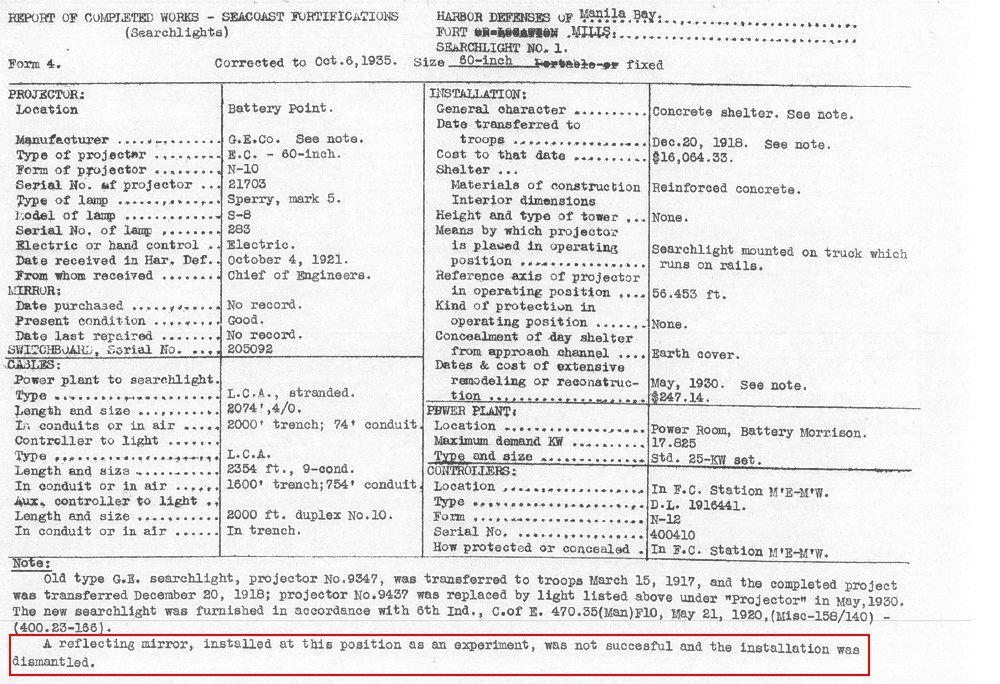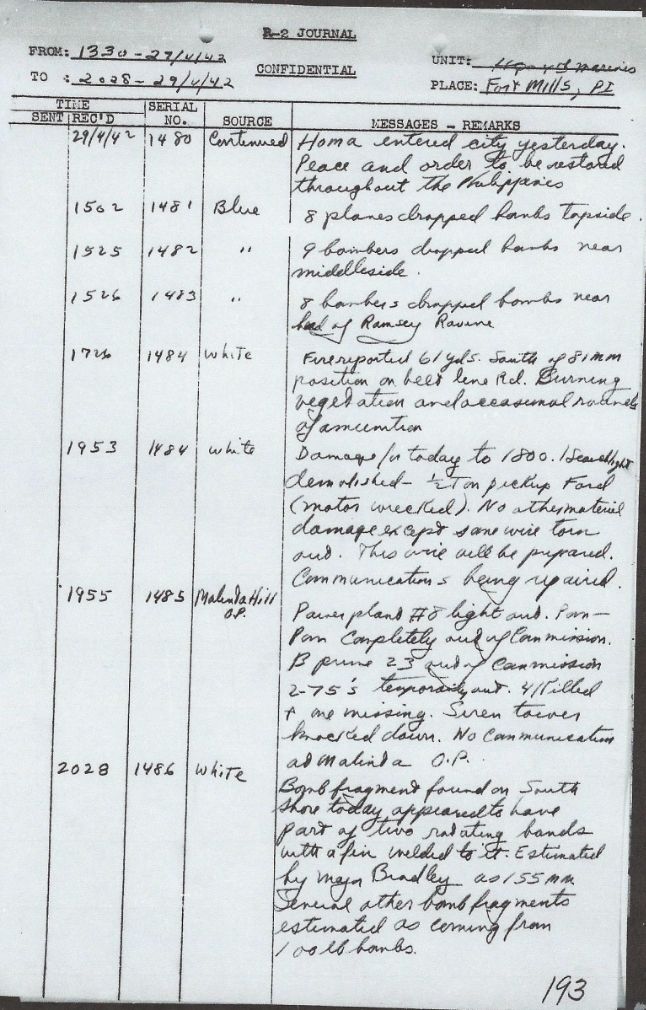Post by fots2 on May 11, 2013 12:22:09 GMT 8
Oozlefinch was not dreaming when he thought that the power plant for Searchlight #8 was in the old Land Defense Magazine. The Report of Completed Works (RCW) for SL#8 clearly states that.
Some information that we now know is:
- SL#8 was transferred to the Army on October 1, 1935
- The 25-KW generator set was (at the time of initial construction) located in the old Land Defense Magazine.
- The Land Defense Magazine was part of IV-S-1 (Sector 4, Siege Gun, Position #1)
- The power cable distance from the SL to the generator was 338’.
- The SL #8 controller was in G-IV-3 which is further south along the ridge top.
- The control cable distance from the SL to G-IV-3 was 522’.
(The quoted cable lengths seem excessive but we do not know the route of the conduits, not direct for sure).

During WWII, 1st Platoon of Battery M (Mobile), 60th Coast Artillery was stationed on top of Malinta Hill. The historical log of that battery was written by Lt. Col. E.L. Barr. Here is his text describing the shell blast and resulting fire that killed Lt. Friedline and four other men.
“Malinta Hill was being worked over by 240's. The report of the guns was deafening, very similar to our 12 inch mortars at Ft. Hughes. The shells made a long lazy somewhat erratic whine then hit Malinta Hill with a great flash of fire and a cloud of dust. The report, a few second later, gave us an idea of the hell it must have been up there. About mid morning we saw that a good sized fire was raging atop the hill near where the pompom was located. We felt a keen anxiety for our men up there but figured that they had one of the safest shell proofs that any of our positions had, in the sea coast searchlight tunnel there.
We learned from some of our men in Malinta Tunnel that the pompom had been blasted out and that Lt. Friedline and some of our men had been burned to death in the fire that had swept through the searchlight tunnel. A 240 mm shell came down a ventilation shaft and exploded the gas tank of the 25 KV generator and the fire swept all through the tunnel. Lt. Friedline and four men died of burns that afternoon and four other men were seriously burned.
We went up to inspect the damage immediately. The pompon and the other machine gun pit were totally destroyed. A crew of engineers was working to extricate some of the bodies caught in the wreckage of the SL tunnel”.
The SL#8 tunnel was described in the RCW as being constructed of concrete. I notice that the large rear ventilation shaft is not mentioned in the report. Perhaps it was added later for some unknown reason.
The 25-KW generator set powering SL#8 was originally installed in the old IV-S-1 Land Defense Magazine. By 1942 it appears to have been moved into the newly constructed ventilation shaft at the rear of SL#8. I can only speculate but perhaps it was thought that the power cables were vunerable to shell fire if the Searchlight power source was remote from the searchlight. The old Land Defense Magazine may have been taken over as a shelter and magazine for the pompom which is was mounted nearly on top of it.
Some information that we now know is:
- SL#8 was transferred to the Army on October 1, 1935
- The 25-KW generator set was (at the time of initial construction) located in the old Land Defense Magazine.
- The Land Defense Magazine was part of IV-S-1 (Sector 4, Siege Gun, Position #1)
- The power cable distance from the SL to the generator was 338’.
- The SL #8 controller was in G-IV-3 which is further south along the ridge top.
- The control cable distance from the SL to G-IV-3 was 522’.
(The quoted cable lengths seem excessive but we do not know the route of the conduits, not direct for sure).

During WWII, 1st Platoon of Battery M (Mobile), 60th Coast Artillery was stationed on top of Malinta Hill. The historical log of that battery was written by Lt. Col. E.L. Barr. Here is his text describing the shell blast and resulting fire that killed Lt. Friedline and four other men.
“Malinta Hill was being worked over by 240's. The report of the guns was deafening, very similar to our 12 inch mortars at Ft. Hughes. The shells made a long lazy somewhat erratic whine then hit Malinta Hill with a great flash of fire and a cloud of dust. The report, a few second later, gave us an idea of the hell it must have been up there. About mid morning we saw that a good sized fire was raging atop the hill near where the pompom was located. We felt a keen anxiety for our men up there but figured that they had one of the safest shell proofs that any of our positions had, in the sea coast searchlight tunnel there.
We learned from some of our men in Malinta Tunnel that the pompom had been blasted out and that Lt. Friedline and some of our men had been burned to death in the fire that had swept through the searchlight tunnel. A 240 mm shell came down a ventilation shaft and exploded the gas tank of the 25 KV generator and the fire swept all through the tunnel. Lt. Friedline and four men died of burns that afternoon and four other men were seriously burned.
We went up to inspect the damage immediately. The pompon and the other machine gun pit were totally destroyed. A crew of engineers was working to extricate some of the bodies caught in the wreckage of the SL tunnel”.
The SL#8 tunnel was described in the RCW as being constructed of concrete. I notice that the large rear ventilation shaft is not mentioned in the report. Perhaps it was added later for some unknown reason.
The 25-KW generator set powering SL#8 was originally installed in the old IV-S-1 Land Defense Magazine. By 1942 it appears to have been moved into the newly constructed ventilation shaft at the rear of SL#8. I can only speculate but perhaps it was thought that the power cables were vunerable to shell fire if the Searchlight power source was remote from the searchlight. The old Land Defense Magazine may have been taken over as a shelter and magazine for the pompom which is was mounted nearly on top of it.






 Hopefully more information will surface.
Hopefully more information will surface. 



 Anyhow, methinks that you have come to the correct conclusion as to the location of the 4th USMC Observation Post. Postscript....I am pleased to know that, during those dismal days, that the good guys were able to put that booze to good use. The Japs had the "Rock", but they missed Colonel Howard"s "medicinal spirits". Thanks for posting this anecdote. Postscript....I am pleased to see you back on the Forum. I, honestly, had started to think that you were ill or had gone AWOL.
Anyhow, methinks that you have come to the correct conclusion as to the location of the 4th USMC Observation Post. Postscript....I am pleased to know that, during those dismal days, that the good guys were able to put that booze to good use. The Japs had the "Rock", but they missed Colonel Howard"s "medicinal spirits". Thanks for posting this anecdote. Postscript....I am pleased to see you back on the Forum. I, honestly, had started to think that you were ill or had gone AWOL.